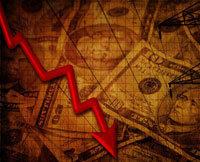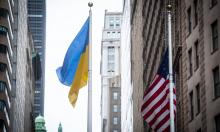Ending economic crisis simply and easily, in America and globally (Part I)
by Stephen Lendman

Some of the best ideas are often the simplest. When applied to the global economic crisis, the solution is easier than imagined. What's hard, in fact a Gordian Knot, is the political will to embrace it. But even matters that great can be solved by a bold stoke, and according to legend, Alexander the Great's "Alexandrian solution" was achieved with one stroke of his sword, cutting the Knot in half. Applied to the global economic crisis, it means addressing it with effective policies, not ones wrecking America and other troubled nations worldwide.
Economist Michael Hudson explains that "debt leveraging is what caused our economic collapse," so piling on more ("The Recovery Plan from Hell" he calls it) makes things worse, especially the way it's done: in America, by a private banking cartel Federal Reserve bailing out its members to enrich them the key giant ones referred to as Wall Street; and the US Treasury doing the same thing; it let the federal debt skyrocket to stratospheric levels and affirmed Adam Smith's dictum in The Wealth of Nations that no country ever repaid its debts, surely not huge ones in a private banking cartel run state, and therein lies the problem - easily solved with a bold stroke, thus far not taken nor will it without mass public action demanding it.
Which is why this article is written, inspired by the work of others. Economist Michael Hudson for one. Global Research.ca editor Michel Chossudovsky another, and noted author and writer Ellen Brown for her extraordinary book titled "Web of Debt" and her explanation of how "Cash-Starved States Need to Play the Banking Game" the same way as North Dakota.
If done at state and federal levels, it can save the economy from Wall Street's predation - by removing the debt overhang through debt write-downs as well as funding sustainable, inflation-free prosperity. It's not a pipe dream. It's real. It happened before and can again. Short of that, according to Hudson: "debt service will (keep) crowd(ing) out spending on goods and services and there will be no recovery. Debt deflation will drag the economy down while assets are transferred further into the hands of the wealthiest 10% of the population (mainly the top 1%), operating via the financial sector."
Eventually the economy will collapse, but Wall Street will profit hugely - aided and abetted by corrupted public officials allied with the private parasitic Federal Reserve turning America into what Hudson calls a "zombie economy" and banana republic.
What Works for North Dakota Can Work for the Other States, America, and Everywhere
On March 2, Brown explained North Dakota's "Banking Game" and asked:
"What does the State of North Dakota have that other states don't....its own bank" - and therein lies its uniqueness and strength. When only four of the 50 states are solvent, North Dakota runs surpluses, and according to the Center on Budget and Policy Priorities, it's expected to have them in FY 2009 and 2010.
In his January 2009 State of the State address, governor John Hoeven explained:
"Since 2000, the State of North Dakota has gained jobs, and now we are gaining population, as well.
Personal income has grown by 43 percent - nearly 15 percent faster than the national average. In fact, our per capita income has moved up 12 places, from 38th to 26th among all the states (despite a tiny 641,481 population, according to 2008 US Census Bureau figures).
Wages have grown 34 percent, compared to just 26 percent for the rest of the country.
Our gross state product since 2000 has grown by nearly $10 billion, from $17.7 billion to more than $27 billion last year - a 56 percent increase - again, faster than the nation.
And our foreign exports have grown by 225 percent since 2000, breaking the $2 billion mark for the first time in North Dakota history.
Furthermore, our economic growth and diversification, along with the good financial stewardship, has enabled us to build a surplus and a solid financial reserve for the future....the state of our state is strong (at a time) our nation's economy is in a down-cycle...."
On May 23, The Bismark Tribune and other state papers reported that North Dakota has the nation's lowest unemployment rate at 4%. Clearly, it has a leg up on the other states, something all their governors and legislators should note along with federal officials in Washington. What works for North Dakota can work everywhere.
The Bank of North Dakota is the only state-owned bank in the nation - established in 1919 by its legislature "to free farmers and small businessmen from the clutches of out-of-state bankers and railroad men," according to Brown quoting management consultant Charles Fleetham in a February 2009 article published in his home state, Michigan. Brown continues:
"Three elected officials oversee the bank: the governor, the attorney general, and the commissioner of agriculture. The bank's mission is to deliver sound financial services that promote agriculture, commerce and industry (and operate) as a bankers' bank, partnering with private banks to loan money to farmers, real estate developers, schools and small businesses." Also to students and private individuals in the state at low affordable rates.
Key though is how it operates and stays solvent when so many of the nation's banks are financially strapped and face bankruptcy. As Brown explains:
"Certified, card-carrying bankers are allowed to do something nobody else can do....create 'credit' with accounting entries on their books." It turns money into credit by what's called "fractional reserve banking" that multiplies each dollar deposited magically into about 10 in the form of loans or computer-generated funds. It's literally money created out of thin air so that banks can re-lend it many times over, and the more deposits, the greater the amount of lending.
At issue is whether credit should be private or public, and as Brown wrote in a December 29 article titled "Borrowing from Peter to Pay Paul: The Wall Street Ponzi Scheme called Fractional Reserve Banking:"
"Readily available credit has made America 'the land of opportunity' ever since the days of the American colonists," with more on that below. "What has transformed this credit system into a Ponzi scheme that must continually be propped up with bailout money is that the credit power has been turned over to private bankers who always require more money back than they create" because they charge high interest rates to make a profit. When governments lend their own money, profit isn't at issue so rates can be low and affordable to businesses, farmers, and private individuals, and for their own and municipality needs, it's interest-free.
Brown and others have explained that "fractional reserve banking" dates from the 17th century, done then mainly in gold and silver coins. Early bankers soon realized it was simpler to use deposit receipts (called notes) as a means of payment. They then began creating money by making loans through promises to pay, and more could be issued than the amount of coins on hand as only enough were needed to service redemptions - today's idea of a reserve requirement.
To be continued...
Subscribe to Pravda.Ru Telegram channel, Facebook, RSS!





